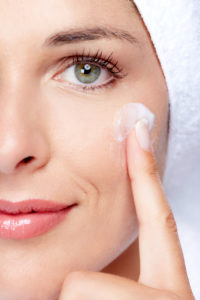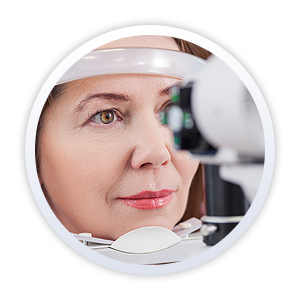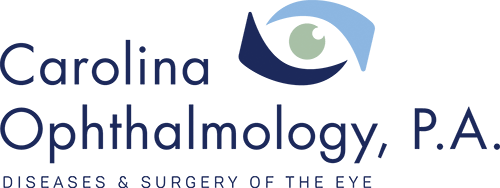By Dr. Christina H. Choe, Oculoplastic Surgeon at Carolina Ophthalmology
Skin quality is one of the major factors contributing to the appearance of aging. As we age, our skin loses collagen and moisture. It develops wrinkles and discolorations or brown spots. In addition, our skin turnover rate slows down allowing the outermost layer of skin to appear dull. High quality skin care can help reduce these signs of aging and reduce the need for more drastic interventions at a later age.
There are four core elements to keeping your skin young, healthy and beautiful. These should be part of any basic skincare regimen to minimize the major signs of aging. The sooner you start the better. Remember, “An ounce of prevention is worth a pound of cure!”
1. SUNSCREEN
Sunscreen is the best, cheapest, and most effective way of preventing signs of skin aging. Sun exposure stimulates melanin production and results in skin discoloration and brown spots. In addition, UV exposure results in free radical production which destroys collagen, a major structural protein in the skin. Collagen gives the skin its strength and durability, and it is responsible for the smooth, plump appearance of young, healthy skin. Finally and most importantly, UV exposure causes gene mutations and increases the risk of developing skin cancer.
The sun emits both UV-A and UV-B rays. While UV-B rays cause sunburns, both UV-B and UV-A rays cause skin damage and increases the risk for skin cancer. Since clouds and windows do not block against UV-A rays, you are at risk of getting sun damage even while indoors on a cloudy day. This is why the telltale areas of someone’s age are their face, hands, and chest, which are the areas that suffer daily sun exposure. Without regular sunscreen use as a foundation to prevent these signs of aging, other anti-aging efforts are futile as the sun will quickly reverse the benefits.
When choosing a sunscreen, look for a sunscreen that is labeled “broad spectrum.” This indicates that the sunscreen blocks both UV-A and UV-B rays. There are 2 broad categories of sunscreens: physical blockers and chemical blockers. Physical blockers (zinc oxide and titanium dioxide) create a barrier preventing UV rays from reaching the skin. Chemical blockers cause a chemical reaction in the skin to absorb and protect against the sun’s rays, which is why they must be applied prior to sun exposure. Physical blockers tend to be better tolerated for sensitive skin, but chemical blockers tend to be more lightweight and versatile (sprays, etc.). Regardless of what type of sunscreen you choose, the most important key is reapplication as all sunscreen loses its effectiveness after 1.5-2 hours and sooner if one is exposed to water activities such as swimming.
What to do:
- Apply a broad-spectrum sunscreen of SPF 30 or greater every day, even if you are indoors. Remember that windows do not block the sun’s harmful rays and you may still be getting harmful sun effects even when indoors.
- If you will be outdoors, wear a hat and sunglasses to further block the sun’s harmful rays. Pick lenses for your sunglasses that block both UV-A and UV-B rays.
- Minimize sun exposure during peak daylight hours (10:00AM – 4:00PM)
- Sunscreen should be reapplied every 1.5-2 hours.
2. RETINOID
Retinoids are a class of chemicals compounds generally labeled as Vitamin A, but includes other compounds which are closely related to Vitamin A in both structure and function. UV exposure stimulates enzymes that destroy collagen in the skin. Retinoids act by blocking these enzymes (known as matrix metalloproteinase). In addition, retinoids have been clinically proven to increase collagen production in the skin, exfoliate the outer skin layer and promote skin turnover, and treat acne by reducing oil production.
There are many forms of retinoids available on the market:
- Retinoic acid is the active form (also known as tretinoin). It is only available by prescription.
- Retinol is commonly available in over the counter products. Retinol is converted by the skin into retinoic acid. However, it needs to be offered in higher concentrations as only about 1/10 will be converted into retinoic acid. This conversion rate can vary from person to person. Because of this conversion factor, look for anti-aging products with at least 0.5-1% retinol to try to reach the clinical benefit found with prescription tretinoin.
- Retinyl Palmitate has not been proven to convert in significant amounts to retinoic acid and thus is unlikely to result in any clinical benefit.
An important thing to remember is that you cannot use these products if you are pregnant or breastfeeding. Use of these products will often result in flakiness and exfoliation so go slowly to allow your skin to become accustomed to the product.
3. ALPHA HYDROXYL ACID (AHA)
Alpha hydroxyl acid aids in exfoliation and sloughing of dull, old, skin cells. AHA acts by breaking up the bonds that hold the outer layer of skin cells together, causing it to slough off and thus aiding in skin renewal. This helps brighten the skin, reduces skin discoloration, tightens pores, and reduces the appearance of fine lines and wrinkles. These same ingredients are commonly used in chemical peels but are also available at weaker concentrations for daily at home use. There are many forms of AHAs but the most common include salicylic acid, glycolic acid, lactic acid, azaleic acid, and trichloracetic acid.
4. ANTIOXIDANTS
Antioxidants neutralize the free radicals that are created by UV exposure, smoking or environmental pollutants. Free radicals are charged oxygen particles that create destructive chemical bonds. This results in the oxidation and destruction of proteins, lipids, and DNA. The long term result is gene mutations, inflammation, and immune system impairment. Examples of oxidation seen in our everyday lives include rusting metals and fruits that brown when exposed to the air. Citrus is a common anti-oxidant and it is the reason why adding lemon juice will preserve the appearance of your apples. Incorporating antioxidants into your skincare will help prevent future aging changes.
Common antioxidants found in skincare products include Vitamin E (alpha tocopherol), Vitamin C (L-ascorbic acid) and green tea extracts (catechins). These have powerful and effective antioxidant effects. In addition, Vitamin C plays an important role in collagen formation and has been shown to increase levels of Type 1 and Type 3 collagen in the skin. However, these antioxidants are often unstable because they oxidize when exposed to air. Once they oxidize, they are no longer effective and in fact may irritate the skin. Thus, special formulations are needed to provide effective levels of antioxidants in the skin.
These 4 elements (sunscreen, retinoid, hydroxyacid, and antioxidant) form the core foundation for anti-aging skincare as they have been clinically proven to reduce and reverse the signs of skin aging. We also recommend a healthy diet, staying hydrated, avoiding drastic weight fluctuations, avoiding sunbathing, and avoiding smoking. These products in addition to a healthy lifestyle will go a long way towards preserving the youthful appearance of your skin.




